Restoration of Off-Road Vehicle (ORV) Trails in a Hyper-Arid Area for Nature and Landscape Conservation
Abstract
1. Introduction
2. Materials and Methods
2.1. Site Description, Experimental Design, and Methods
2.2. Data Analysis
3. Results
3.1. Soil
3.2. Vegetation
4. Discussion
4.1. Soil
4.2. Vegetation
5. Conclusions
Author Contributions
Funding
Data Availability Statement
Acknowledgments
Conflicts of Interest
Appendix A. Statistical Test Results of Treatment Comparison
| Comparison | Difference | Lower | Upper | Adj. p-Value |
|---|---|---|---|---|
| No disk–Control | −6.63 | −10.6459 | −2.6141 | 0.0023 |
| Disk–Control | 1.6587 | −2.3572 | 5.6745 | 0.531 |
| Disk–No disk | 8.2887 | 4.2728 | 12.3045 | 0.0004 |
| Comparison | Difference | Lower | Upper | Adj. p-Value |
|---|---|---|---|---|
| No disk–Control | 14.8833 | −0.7564 | 30.5231 | 0.0651 |
| Disk–Control | 7.5228 | −8.117 | 23.1625 | 0.4799 |
| Disk–No disk | −7.3606 | −23.0003 | 8.2792 | 0.4949 |
| Variable | Comparison | Difference | Lower | Upper | Adj. p-Value |
|---|---|---|---|---|---|
| Cover (%) | No disk–Control | −4.7057 | −7.9648 | −1.4465 | 0.0026 |
| Cover (%) | Disk–Control | −3.0863 | −6.3455 | 0.1728 | 0.0673 |
| Cover (%) | Disk–No disk | 1.6193 | −1.6398 | 4.8785 | 0.4649 |
| # of individuals | No disk–Control | −61.45 | −82.8085 | −40.0915 | <0.001 |
| # of individuals | Disk–Control | −52.8667 | −74.2252 | −31.5082 | <0.001 |
| # of individuals | Disk–No disk | 8.5833 | −12.7752 | 29.9418 | 0.6046 |
| Height (cm) | No disk–Control | −1.7678 | −4.828 | 1.2924 | 0.3566 |
| Height (cm) | Disk–Control | −1.9374 | −4.9976 | 1.1227 | 0.291 |
| Height (cm) | Disk–No disk | −0.1696 | −3.2298 | 2.8905 | 0.9904 |
| # of species | No disk–Control | −2.4333 | −4.5462 | −0.3205 | 0.0199 |
| # of species | Disk–Control | 1.8667 | −0.2462 | 3.9795 | 0.0943 |
| # of species | Disk–No disk | 4.3 | 2.1871 | 6.4129 | <0.001 |
| Diversity H’ | No disk–Control | −0.2869 | −0.5871 | 0.0134 | 0.0642 |
| Diversity H’ | Disk–Control | 0.3967 | 0.0964 | 0.6969 | 0.0063 |
| Diversity H’ | Disk–No disk | 0.6835 | 0.3833 | 0.9838 | <0.001 |
| Comparison | Adj. p-Value |
|---|---|
| No disk–Control | 0.067 |
| Disk–Control | 0.003 |
| Disk–No disk | 0.003 |
References
- Ploughe, L.W.; Fraser, L.H. Find New RoadsTM? A Systematic Review on the Impacts of Off-Road Vehicle Activity on Soil, Vegetation, and Wildlife. Front. Ecol. Evol. 2022, 9, 805707. [Google Scholar] [CrossRef]
- Kutiel, P. Tendencies in the development of tracks in open areas. Environ. Manag. 1999, 23, 401–408. [Google Scholar] [CrossRef] [PubMed]
- Kutiel, P.; Zhevelev, H.; Harrison, R. The effect of recreational impacts on soil and vegetation of stabilised coastal dunes in the Sharon Park, Israel. Ocean Coast. Manag. 1999, 42, 1041–1060. [Google Scholar] [CrossRef]
- Fischer, J.; Lindenmayer, D.B. Landscape modification and habitat fragmentation: A synthesis. Glob. Ecol. Biogeogr. 2007, 16, 265–280. [Google Scholar] [CrossRef]
- Leney, F. The Effect of Public Recreation on Picnic Sites. Ph.D. Thesis, Department of Botany, University of Aberdeen, Aberdeen, UK, 1974. [Google Scholar]
- Liddle, M.; Greig-Smith, P. A survey of tracks and paths in a sand dune ecosystem I. Soils. J. Appl. Ecol. 1975, 12, 893–908. [Google Scholar] [CrossRef]
- Weaver, T.; Dale, D. Trampling effects of hikers, motorcycles and horses in meadows and forests. J. Appl. Ecol. 1978, 15, 451–457. [Google Scholar] [CrossRef]
- Bowles, J.M.; Maun, M.A. A study of the effects of trampling on the vegetation of Lake Huron sand dunes at Pinery Provincial Park. Biol. Conserv. 1982, 24, 273–283. [Google Scholar] [CrossRef]
- Kuss, F.R. A review of major factors influencing plant responses to recreation impacts. Environ. Manag. 1986, 10, 637–650. [Google Scholar] [CrossRef]
- Cole, D.N. Research on soil and vegetation in wilderness: A state-of-knowledge review. In Proceedings of the National Wilderness Research Conference: Issues, State-of-Knowledge, Future Directions, Fort Collins, CO, USA, 23–26 July 1987; pp. 135–177. [Google Scholar]
- Cole, D.N. Experimental trampling of vegetation. I. Relationship between trampling intensity and vegetation response. J. Appl. Ecol. 1995, 32, 203–214. [Google Scholar] [CrossRef]
- Cole, D.N. Experimental trampling of vegetation. II. Predictors of resistance and resilience. J. Appl. Ecol. 1995, 32, 215–224. [Google Scholar] [CrossRef]
- Rickard, C.; McLachlan, A.; Kerley, G. The effects of vehicular and pedestrian traffic on dune vegetation in South Africa. Ocean Coast. Manag. 1994, 23, 225–247. [Google Scholar] [CrossRef]
- Liddle, M. A theoretical relationship between the primary productivity of vegetation and its ability to tolerate trampling. Biol. Conserv. 1975, 8, 251–255. [Google Scholar] [CrossRef]
- Hall, C.N.; Kuss, F.R. Vegetation alteration along trails in Shenandoah National park, Virginia. Biol. Conserv. 1989, 48, 211–227. [Google Scholar] [CrossRef]
- Sun, D.; Liddle, M.J. Plant morphological characteristics and resistance to simulated trampling. Environ. Manag. 1993, 17, 511–521. [Google Scholar] [CrossRef]
- Kutiel, P.; Eden, E.; Zhevelev, Y. Effect of experimental trampling and off-road motorcycle traffic on soil and vegetation of stabilized coastal dunes, Israel. Environ. Conserv. 2000, 27, 14–23. [Google Scholar] [CrossRef]
- Kutiel, P.; Zhevelev, Y. Recreational use impact on soil and vegetation at picnic sites in Aleppo pine forests onMount Carmel, Israel. Isr. J. Plant Sci. 2001, 49, 49–56. [Google Scholar] [CrossRef]
- Kutiel, P.; Eden, Z.; Zhevelev, H. The impact of motorcycle traffic on soil and vegetation of stabilized coastal dunes, Israel. J. Coast. Conserv. 2001, 7, 81–90. [Google Scholar] [CrossRef]
- Bar, P. Visitor trampling impacts on soil and vegetation: The case study of Ramat Hanadiv Park, Israel. Isr. J. Plant Sci. 2017, 64, 145–161. [Google Scholar]
- Li, L.; Sandu, C. On the impact of cargo weight, vehicle parameters, and terrain characteristics on the prediction of traction for off-road vehicles. J. Terramech. 2007, 44, 221–238. [Google Scholar] [CrossRef]
- Assaeed, A.M.; Al-Rowaily, S.L.; El-Bana, M.I.; Abood, A.A.; Dar, B.A.; Hegazy, A.K. Impact of off-road vehicles on soil and vegetation in a desert rangeland in Saudi Arabia. Saudi J. Biol. Sci. 2018, 26, 1187. [Google Scholar] [CrossRef]
- Dregne, H.E. Soil and soil formation in arid regions. In Environmental Effects of Off-Road Vehicles: Impacts and Management in Arid Regions; Springer: New York, NY, USA, 1983; pp. 15–30. [Google Scholar]
- Belnap, J. Surface disturbances: Their role in accelerating desertification. Environ. Monit. Assess. 1995, 37, 39–57. [Google Scholar] [CrossRef] [PubMed]
- Webb, R.H.; Wilshire, H.G. Environmental Effects of Off-Road Vehicles: Impacts and Management in Arid Regions; Springer Science & Business Media: New York, NY, USA, 2012. [Google Scholar]
- Webb, R.H. Compaction of Desert Soils by Off-Road Vehicles. In Environmental Effects of Off-Road Vehicles; Springer Series on Environmental Management; Springer: New York, NY, USA, 1983; pp. 51–79. [Google Scholar]
- Dubey, A.A.; Dhami, N.K.; Ravi, K.; Mukherjee, A. Erosion mitigation with biocementation: A review on applications, challenges, & future perspectives. Rev. Environ. Sci. Bio/Technol. 2023, 22, 1059–1091. [Google Scholar]
- Stavi, I.; Siegal, Z.; Drori, B.; Hyams, E.; Shafir, A.; Kamiski, Y.; Al-Ashhab, A.; Dorman, M.; Tsoar, A. Single Session of Chiseling Tillage for Soil and Vegetation Restoration in Severely Degraded Shrublands. Water 2018, 10, 755. [Google Scholar] [CrossRef]
- Stavi, I.; Pulido Fernández, M.; Argaman, E. Long-term passive restoration of severely de-graded drylands—Divergent impacts on soil and vegetation: An Israeli case study. J. Geogr. Sci. 2023, 33, 529–546. [Google Scholar] [CrossRef]
- Cole, D.N.; Landres, P.B. Indirect effects of recreation on wildlife. In Wildlife and Recreationists: Coexistence Through Management and Research; Knight, R.L., Gutzwiller, K.J., Eds.; Island Press: Washington, DC, USA, 1995; Chapter 11; pp. 183–202. [Google Scholar]
- Bolling, J.D.; Walker, L.R. Plant and soil recovery along a series of abandoned desert roads. J. Arid Environ. 2000, 46, 1–24. [Google Scholar] [CrossRef]
- Kuss, F.R.; Hall, C.N. Ground flora trampling studies: Five years after closure. Environ. Manag. 1991, 15, 715–727. [Google Scholar] [CrossRef]
- FAO. World Reference Base for Soil Resources 2014: International Soil Classification System for Naming Soils and Creating Legends for Soil Maps, Update 2015; Technical Report; Food and Agriculture Organization of the United Nations: Rome, Italy, 2015. [Google Scholar]
- Danin, A. Desert Vegetation of Israel and Sinai; Cana: Jerusalem, Israel, 1983. [Google Scholar]
- Gutterman, Y.; Gendler, T.; Huang, Z.Y. Plant dispersal strategies, seed bank distribution and germination of Negev desert species. In Seeds: Biology, Development and Ecology; CABI Publishing: Wallingford, UK, 2007; pp. 407–415. [Google Scholar]
- R Core Team. R: A Language and Environment for Statistical Computing; R Foundation for Statistical Computing: Vienna, Austria, 2024. [Google Scholar]
- Oksanen, J.; Simpson, G.; Blanchet, F.; Kindt, R.; Legendre, P.; Minchin, P.; O’Hara, R.; Solymos, P.; Stevens, M.; Szoecs, E.; et al. Vegan: Community Ecology Package, R Package Version 2.6-8. 2024. [Google Scholar]
- Wickham, H. ggplot2: Elegant Graphics for Data Analysis; Springer: New York, NY, USA, 2016. [Google Scholar]
- Snyder, K.; Tartowski, S. Multi-scale temporal variation in water availability: Implications for vegetation dynamics in arid and semi-arid ecosystems. J. Arid Environ. 2006, 65, 219–234. [Google Scholar] [CrossRef]
- Pereira, J.S.; Chaves, M.M.; Caldeira, M.C.; Correia, A.V. Water availability and productivity. In Plant Growth and Climate Change; Wiley: Hoboken, NJ, USA, 2006; pp. 118–145. [Google Scholar]
- Alaoui, A.; Lipiec, J.; Gerke, H. A review of the changes in the soil pore system due to soil deformation: A hydrodynamic perspective. Soil Tillage Res. 2011, 115, 1–15. [Google Scholar] [CrossRef]
- Brown, G.; Schoknecht, N. Off-road vehicles and vegetation patterning in a degraded desert ecosystem in Kuwait. J. Arid Environ. 2001, 49, 413–427. [Google Scholar] [CrossRef]
- Li, Z.; Gao, X.; Hong, G.; Yang, H.; Hu, E.; Liu, C.; Wang, X.; Liu, G.; Gao, R. Shallow tillage mitigates plant competition by increasing diversity and altering plant community assembly process. Front. Plant Sci. 2024, 15, 1409493. [Google Scholar] [CrossRef]
- Boeken, B.; Shachak, M. The dynamics of abundance and incidence of annual plant species during colonization in a desert. Ecography 1998, 21, 63–73. [Google Scholar] [CrossRef]
- Boeken, B.; Shachak, M. Colonization by annual plants of an experimentally altered desert landscape: Source—Sink relationships. J. Ecol. 1998, 86, 804–814. [Google Scholar] [CrossRef]
- Grime, J.P. Competitive exclusion in herbaceous vegetation. Nature 1973, 242, 344–347. [Google Scholar] [CrossRef]
- Gutterman, Y. Gymnarrhena micrantha. In Handbook of Flowering; CRC Press: Boca Raton, FL, USA, 2019; pp. 356–360. [Google Scholar]
- Kollwr, D.; Roth, N. Studies on the ecological and physiological significance of amphicarpy in Gymnarrhena micrantha (Compositae). Am. J. Bot. 1964, 51, 26–35. [Google Scholar] [CrossRef]
- Kravtsova, T. Fruit structure in amphicarpic annual Gymnarrhena micrantha (Asteraceae, Gymnarrheneae) in relation to the species biology. Int. J. Plant Biol. 2023, 14, 397–417. [Google Scholar] [CrossRef]
- Abraham, Y.; Elbaum, R. Hygroscopic movements in Geraniaceae: The structural variations that are responsible for coiling or bending. New Phytol. 2013, 199, 584–594. [Google Scholar] [CrossRef]
- Davidson, E.; Fox, M. Effects of off-road motorcycle activity on Mojave Desert vegetation and soil. Madrono 1974, 22, 381–390. [Google Scholar]
- Fischer, R.; Turner, N.C. Plant productivity in the arid and semiarid zones. Annu. Rev. Plant Physiol. 1978, 29, 277–317. [Google Scholar] [CrossRef]
- Alhamad, M.N. Ecological and species diversity of arid Mediterranean grazing land vegetation. J. Arid Environ. 2006, 66, 698–715. [Google Scholar] [CrossRef]
- Hegazy, A.K.; Doust, J.L. Plant Ecology in the Middle East; Oxford University Press: Oxford, UK, 2016. [Google Scholar]
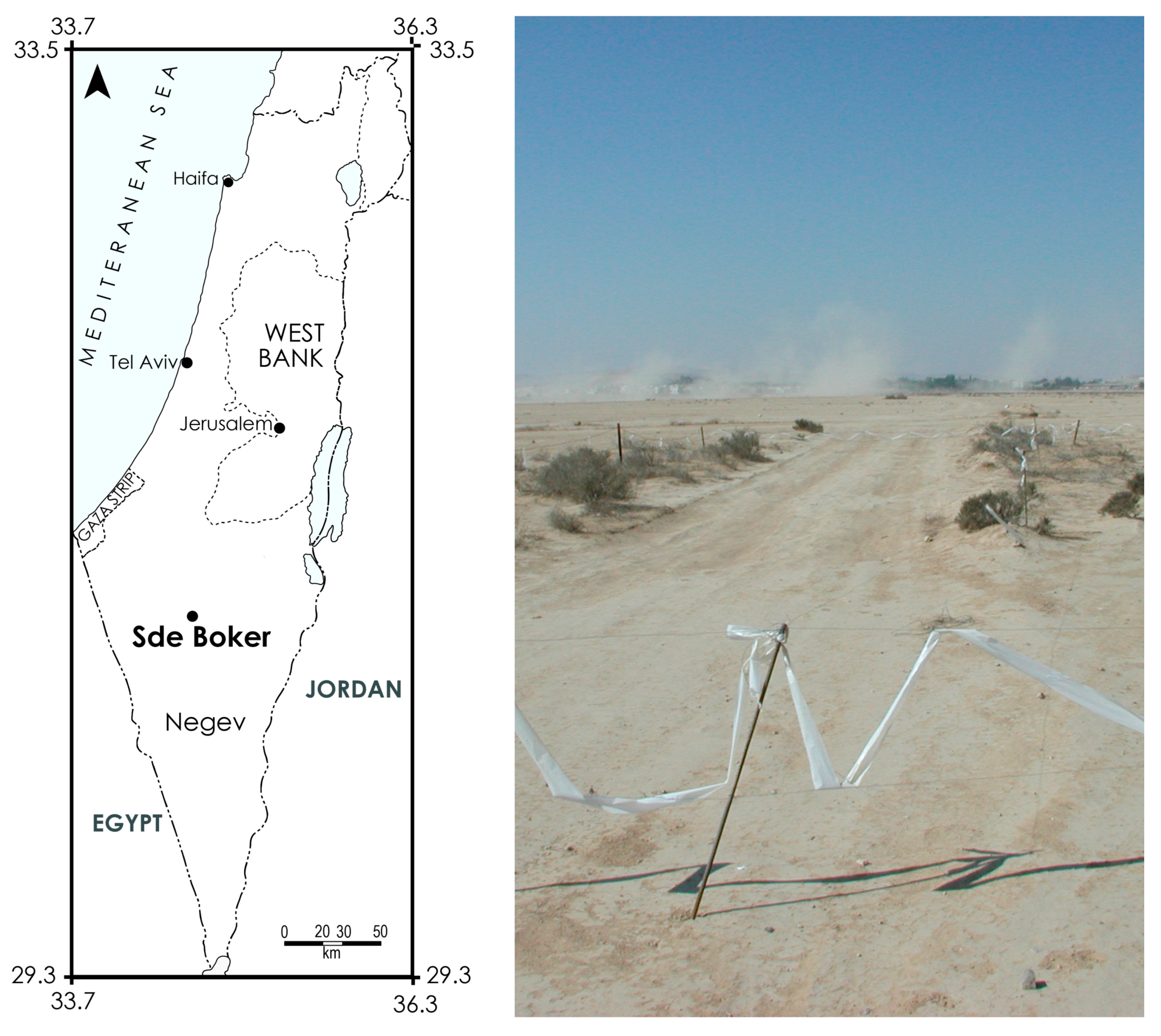
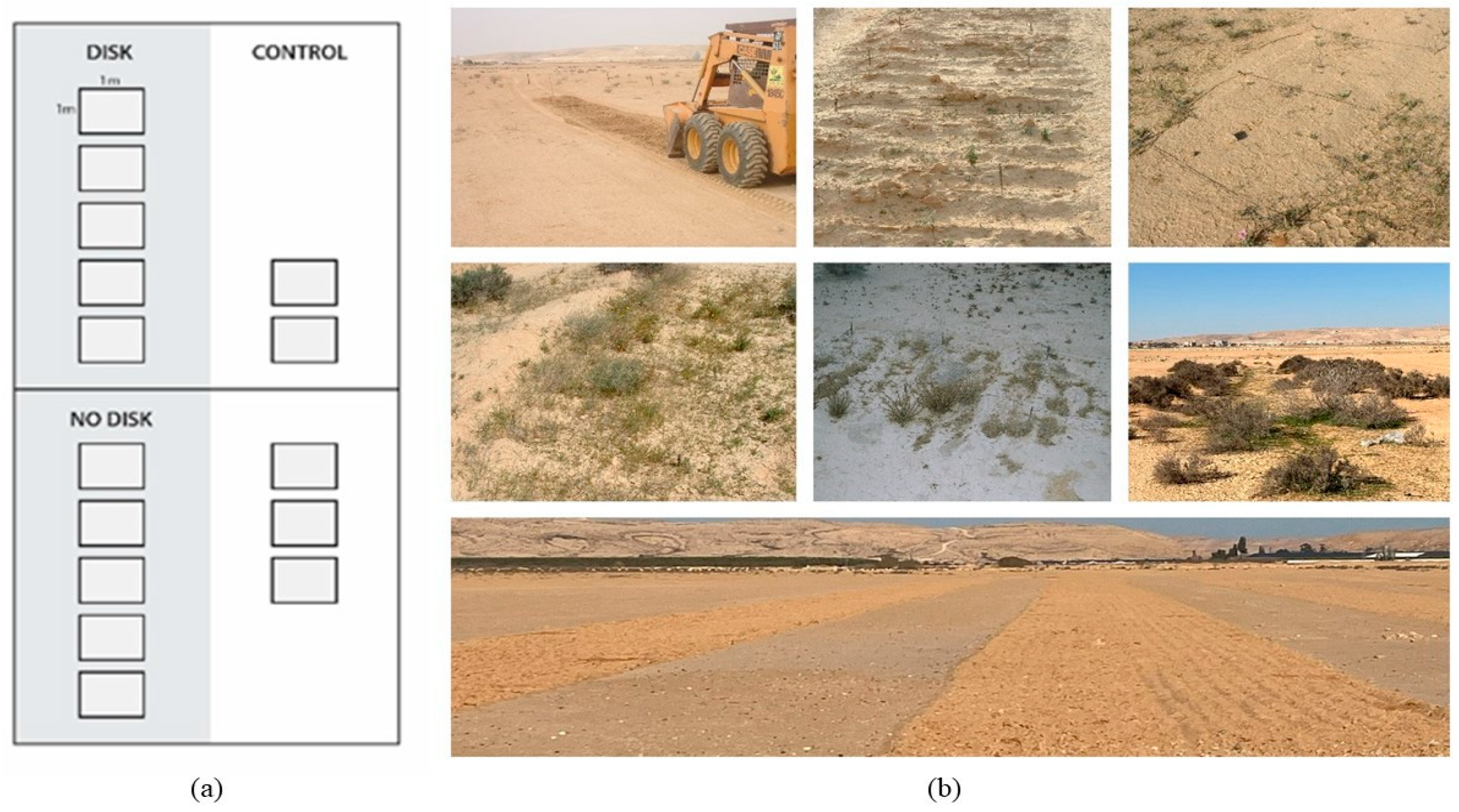

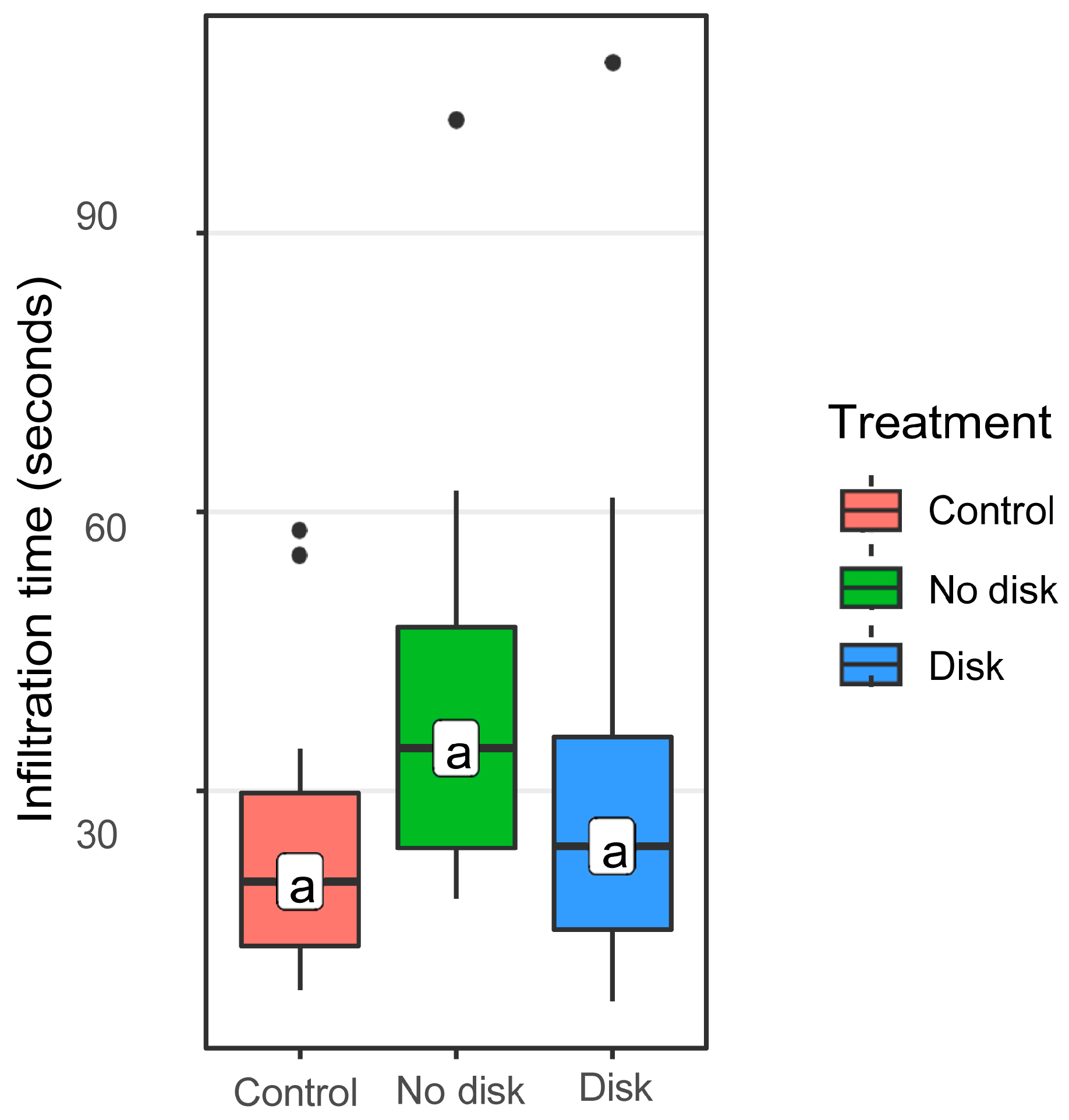
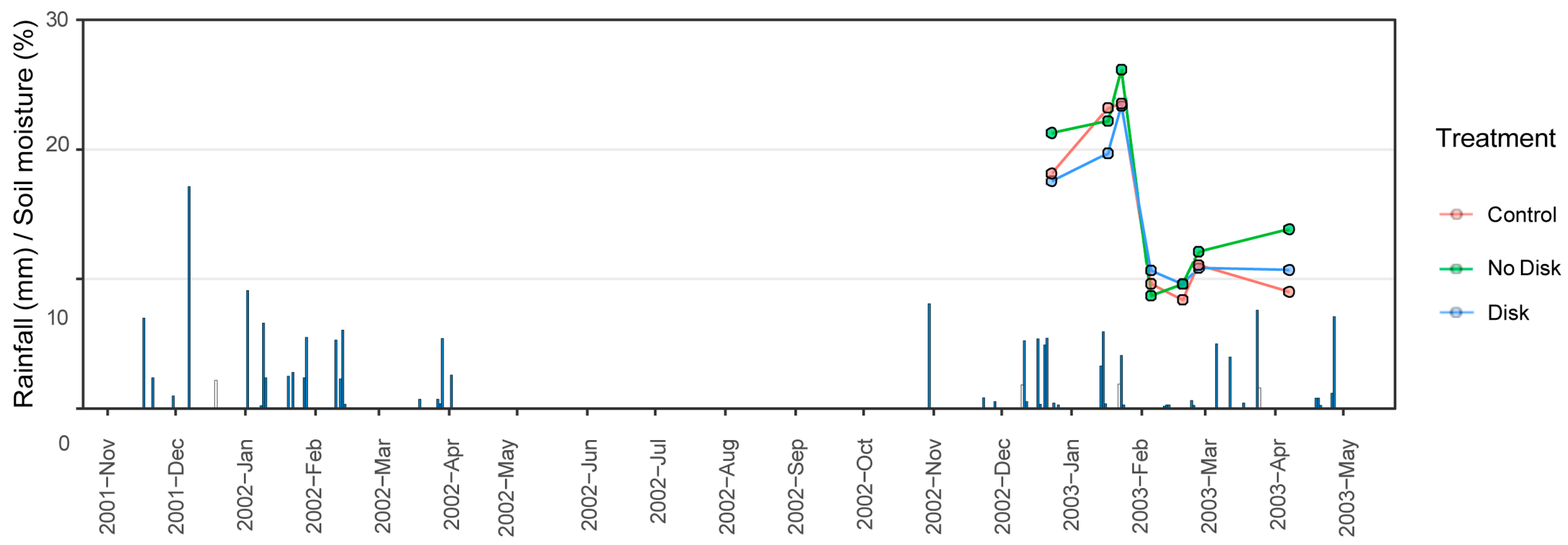

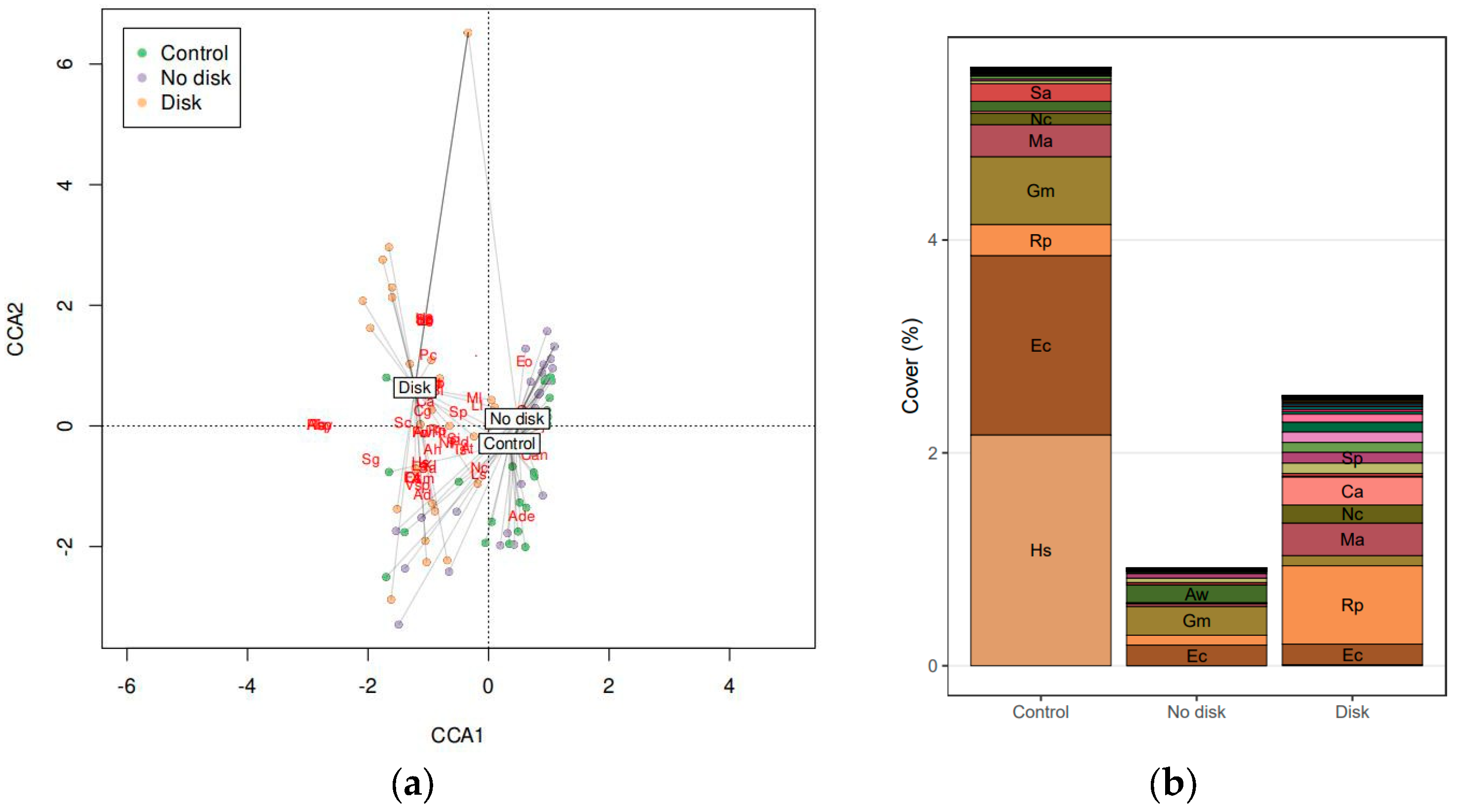
Disclaimer/Publisher’s Note: The statements, opinions and data contained in all publications are solely those of the individual author(s) and contributor(s) and not of MDPI and/or the editor(s). MDPI and/or the editor(s) disclaim responsibility for any injury to people or property resulting from any ideas, methods, instructions or products referred to in the content. |
© 2025 by the authors. Licensee MDPI, Basel, Switzerland. This article is an open access article distributed under the terms and conditions of the Creative Commons Attribution (CC BY) license (https://creativecommons.org/licenses/by/4.0/).
Share and Cite
Bar, P.; Doron, E.; Dorman, M. Restoration of Off-Road Vehicle (ORV) Trails in a Hyper-Arid Area for Nature and Landscape Conservation. Appl. Sci. 2025, 15, 6718. https://doi.org/10.3390/app15126718
Bar P, Doron E, Dorman M. Restoration of Off-Road Vehicle (ORV) Trails in a Hyper-Arid Area for Nature and Landscape Conservation. Applied Sciences. 2025; 15(12):6718. https://doi.org/10.3390/app15126718
Chicago/Turabian StyleBar (Kutiel), Pua, Eran Doron, and Michael Dorman. 2025. "Restoration of Off-Road Vehicle (ORV) Trails in a Hyper-Arid Area for Nature and Landscape Conservation" Applied Sciences 15, no. 12: 6718. https://doi.org/10.3390/app15126718
APA StyleBar, P., Doron, E., & Dorman, M. (2025). Restoration of Off-Road Vehicle (ORV) Trails in a Hyper-Arid Area for Nature and Landscape Conservation. Applied Sciences, 15(12), 6718. https://doi.org/10.3390/app15126718






